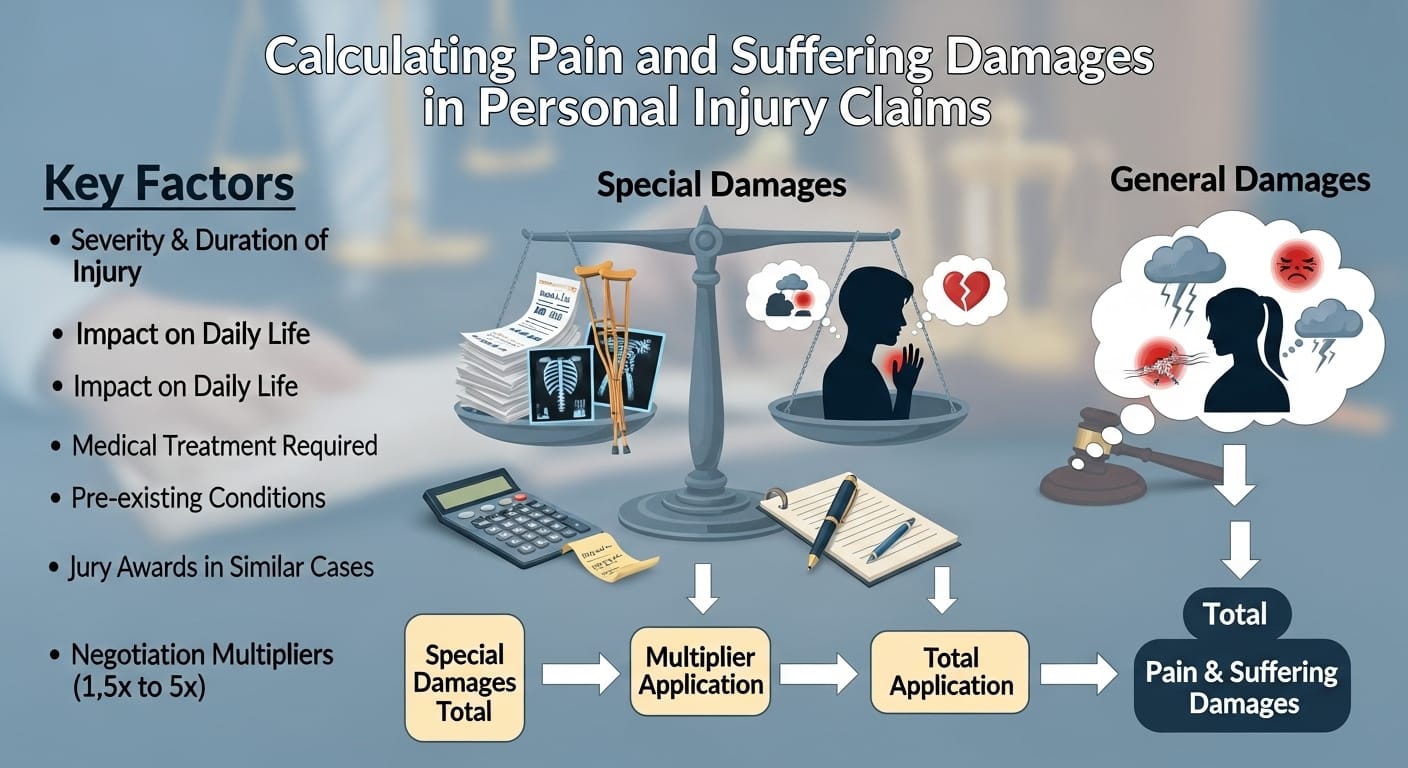Please Note: This post may contain affiliate links. If you click one of them, we may receive a commission at no extra cost to you. As an Amazon Associate, I earn from qualifying purchases.
Ah, pain and suffering—the not-so-fun part of personal injury claims. It’s a term that sounds like it belongs in a soap opera, but trust me, it’s as real as your last trip to the dentist.
If you’ve been injured due to someone else’s negligence, calculating these damages can feel like trying to find a needle in a haystack—blindfolded. But don’t worry! I’m here to break it down for you with all the grace of a gazelle on roller skates.

Top Takeaways and Key Concepts
Understand Pain and Suffering: Includes both physical injuries and emotional distress caused by the incident.
Document Everything: Keep medical records, bills, witness statements, photos, and daily journals to support your claim.
Know the Calculation Methods: Use the multiplier or per diem method to estimate non-economic damages.
Avoid Common Mistakes: Don’t underestimate emotional distress, ignore documentation, or settle too early.
Seek Professional Guidance: Personal injury attorneys can maximize compensation and help navigate complex legal procedures.
Summary of This Article
The article explains pain and suffering damages in personal injury claims, emphasizing both physical and emotional impacts. It outlines the multiplier and per diem methods for calculating compensation and stresses the importance of thorough documentation, including medical records, witness statements, and journals. Common mistakes such as undervaluing emotional distress, neglecting records, or settling prematurely are highlighted. Finally, it advises consulting personal injury attorneys to ensure fair compensation and proper navigation of the legal process, reinforcing the need to know and assert your rights.
What Are Pain and Suffering Damages?

Let’s start by defining what we mean when we say “pain and suffering.” This isn’t just about physical pain—although if you’ve stubbed your toe on the coffee table, you know how serious that can be!
In legal terms, pain and suffering damages refer to the emotional distress, mental anguish, loss of enjoyment of life, and yes, even those sleepless nights spent tossing and turning while dreaming of revenge against that dastardly coffee table.
Interestingly enough, courts recognize both physical and psychological impacts when awarding these damages. So, if you’ve been feeling more anxious than a cat at a dog show since your accident, that’s something worth noting!
The Two Types of Pain and Suffering
Now that we have our definitions sorted out let’s dive into the two main categories: physical pain and emotional distress.
1. Physical Pain: This is pretty straightforward. Did you break an arm? Strain your back? Get hit by a rogue shopping cart? All these injuries come with their own brand of discomfort—and they count! To prove this type of damage effectively, you’ll need medical documentation detailing your injuries and treatment plans.
2. Emotional Distress: Here comes the tricky part! Emotional distress includes anxiety, depression, or any psychological impact stemming from your injury. How do you quantify feelings? Well, it’s not easy—but therapists’ notes or testimony from loved ones can help paint a clearer picture for the court.
By the way, think about how much value you’d place on your happiness before versus after an injury; it might surprise you!
How Are These Damages Calculated?
Calculating pain and suffering isn’t as simple as adding up hospital bills (which would be too easy). Instead, attorneys often use one of two methods: the multiplier method or the per diem method.
Multiplier Method
This approach takes your total economic damages (like medical bills) and multiplies them by a number typically between 1.5 to 5 based on severity. For instance:
– If your medical expenses are $10,000,
– And let’s say you’re feeling particularly dramatic about your recovery,
– Your lawyer might argue for a multiplier of 3.
So now you’re looking at $30,000 for pain and suffering alone! Not too shabby for some bruises from that shopping cart incident!
Per Diem Method
Alternatively, there’s the per diem method—Latin for “each day” (and also how I justify my daily ice cream habit). With this method, you assign a dollar amount to each day you’re affected by your injuries.
For example:
– You decide $100 per day seems fair because every morning feels like climbing Mount Everest.
– If you’ve been dealing with this agony for three months (90 days), you’d claim $9,000 in non-economic damages.
Both methods have their pros and cons; it really depends on individual circumstances.
Gathering Evidence: A Must!
Alrighty then! Now that we’ve discussed calculations let’s talk evidence because without proof—you’re basically just shouting into an empty void (or worse yet—a courtroom full of skeptical jurors).
You’ll want to gather everything related to your case:
– Medical records
– Bills
– Witness statements
– Photos showing how miserable you looked during recovery (bonus points if there are funny faces involved!)
And speaking of which—don’t forget about journals where you document daily struggles post-injury. These little nuggets can serve as powerful tools when arguing for compensation!
Common Mistakes to Avoid
As with any complex process involving money—and possibly lawyers—there are pitfalls aplenty waiting to ensnare unsuspecting victims like yourself! Here are some common mistakes:
1. Underestimating Emotional Distress: Don’t sell yourself short; if you’re having sleepless nights filled with nightmares about rogue shopping carts taking over society—it matters!
2. Ignoring Documentation: Failing to keep thorough records could lead to losing potential compensation faster than I lose my car keys every morning.
3. Settling Too Early: Just because someone offers cash doesn’t mean it’s fair compensation! Make sure all future costs are accounted for before signing anything.
To be fair—I get why people rush into settlements; sometimes it’s tempting when facing mounting bills—but patience pays off here!
Conclusion: Know Your Worth
In conclusion—calculating pain and suffering damages requires time and diligence but knowing what you’re entitled to is crucial! Don’t hesitate to lean on professionals who specialize in personal injury law—they’re there not just for their stunning good looks but also their expertise!
Remember: You’re not just claiming money; you’re advocating for yourself after an injury caused by someone else’s negligence—and that’s nothing short of heroic!
Suggested Resources:
Understanding Personal Injury Claims
https://www.nolo.com/legal-encyclopedia/understanding-personal-injury-claims.html
How Much Is My Personal Injury Claim Worth?
https://www.findlaw.com/personal-injury/how-much-is-my-personal-injury-claim-worth-.html
Pain & Suffering Damages Explained
https://www.hg.org/legal-articles/pain-and-suffering-damages-explained-32036
Frequently Asked Questions
What are pain and suffering damages in a personal injury claim?
Pain and suffering damages include both physical pain and emotional distress resulting from an injury caused by another party’s negligence.
How are pain and suffering damages calculated?
They are typically calculated using either the multiplier method, which multiplies economic damages by a set factor, or the per diem method, assigning a daily rate for suffering.
What evidence supports a pain and suffering claim?
Medical records, bills, witness statements, photos, and personal journals documenting pain and emotional impact strengthen your claim.
What’s the difference between physical pain and emotional distress?
Physical pain refers to bodily injuries, while emotional distress covers anxiety, depression, and mental anguish caused by the injury.
Why should I avoid settling too early in my claim?
Settling too early may cause you to accept less than your injury is worth, especially before knowing the full extent of long-term physical or emotional effects.
How can an attorney help with calculating pain and suffering damages?
A personal injury attorney can evaluate your case, determine fair compensation, and negotiate with insurance companies for the best possible outcome.
Can I claim pain and suffering without physical injuries?
In some cases, yes. Emotional distress claims are possible if you can prove mental anguish, anxiety, or trauma directly resulting from the incident.

Kevin Collier is a legal expert passionate about simplifying complex legal concepts for everyday individuals. With a focus on providing clear, practical information, he covers a wide range of topics, including rights, responsibilities, and legal procedures. Kevin aims to empower readers with the knowledge they need to navigate the legal landscape confidently, ensuring they can make informed decisions regarding their legal matters. Through insightful articles and easy-to-understand resources, he helps demystify the law, making it accessible to all.










